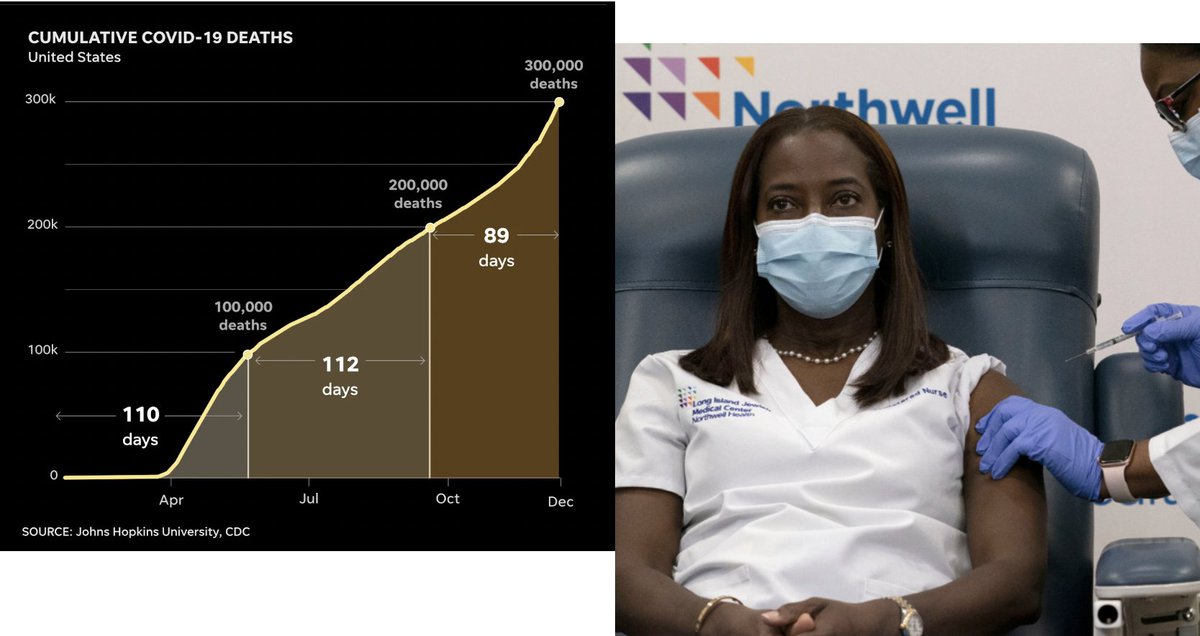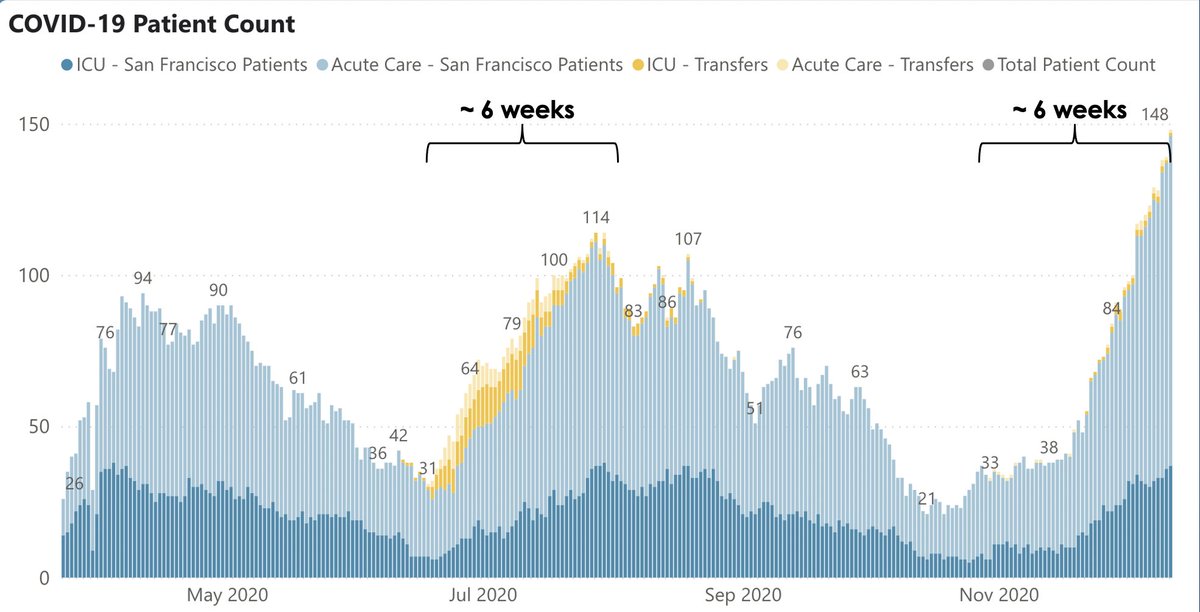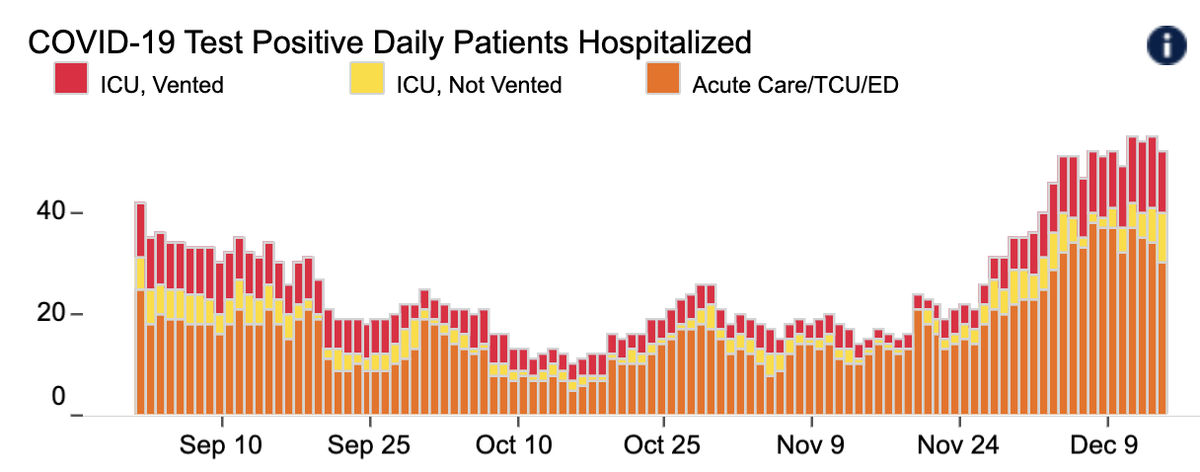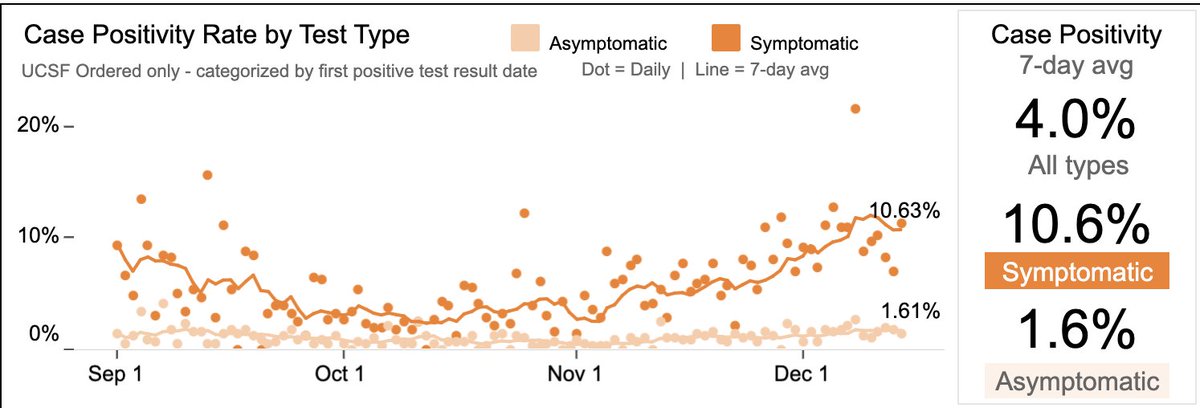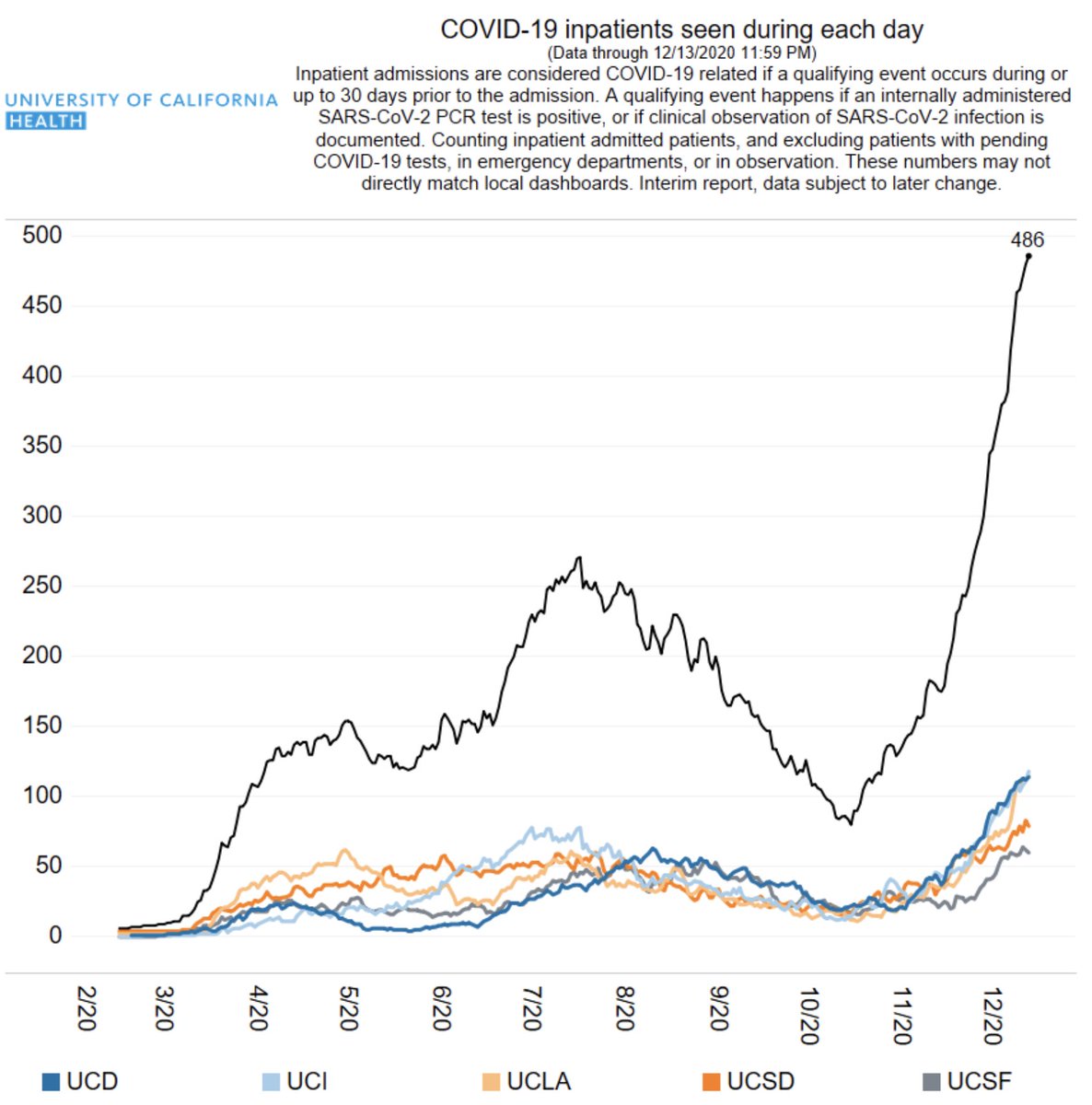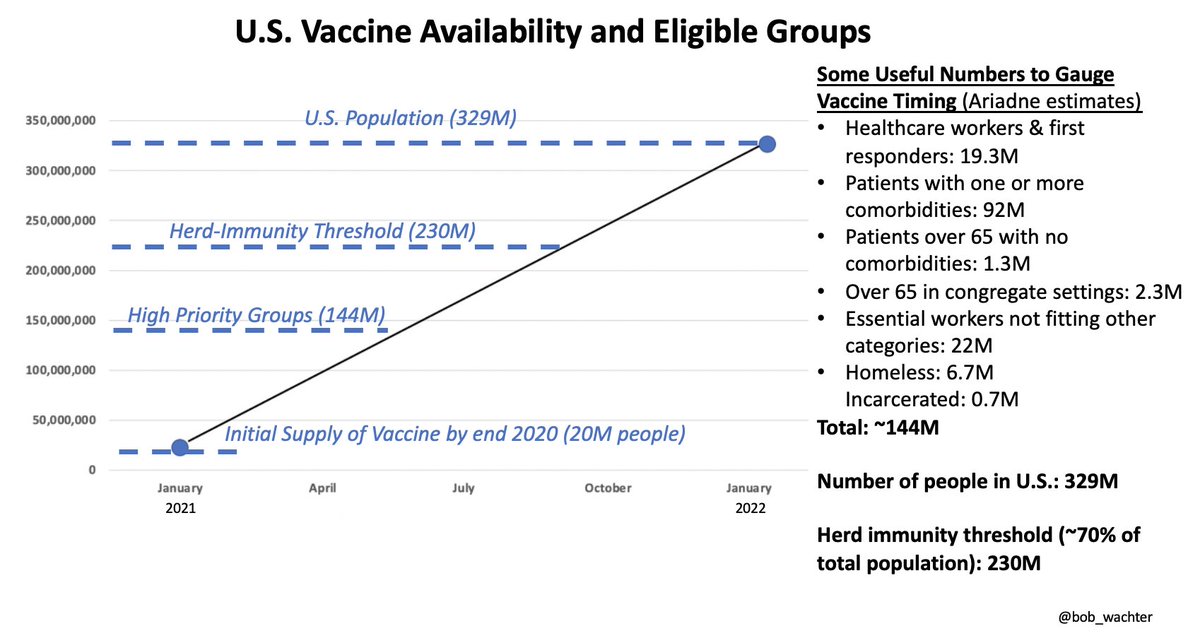1/ Covid ( @UCSF) Chronicles, Day 272
The juxtaposition is jarring: the first U.S. vaccine recipient on the day we hit 300,000 deaths. So much tragedy amid the hopefulness. Today, after an update on SF, I’ll lay out some complex issues that will play out in the next few months.
The juxtaposition is jarring: the first U.S. vaccine recipient on the day we hit 300,000 deaths. So much tragedy amid the hopefulness. Today, after an update on SF, I’ll lay out some complex issues that will play out in the next few months.
2/ San Francisco is now seeing its first big surge, & everybody's asking when the city will turn things around. After having stomped on the curve in March & quickly turned back a surge in June, I thought – if anybody can control this surge – it would be SF. I may have been wrong.
3/ The curve of SF hospitalizations (Fig) shows no signs of plateau after 6 wks, despite stay-at-home orders (note that June surge had plateaued by 6 wks). The combo of pandemic fatigue, colder weather, and the holidays has given the virus the upper hand. We’re losing the battle.
4/ Mirroring the city, Covid is hot @UCSFHospitals. We now have 52 Covid patients, w/ 22 in ICUs & 11 on vents – all at/near record levels for us (Fig L). UCSF test positivity rate is up to 4%: 10.6% in symptomatic pts, 1.6% in pts w/o symptoms. Test positivity in SF is also ~4%.
5/ Rest of CA is even worse, w/ test positivity now 10.5% & 33,000 new diagnoses/day. Below: scary curve from the 5 UC med centers: a total of 486 Covid patients at the 5 hospitals, nearly 2x prior peak. Since UCSF has “just” 52, the other 4 sites averaging ~110 pts in hospital.
6/ While deaths are surging all over U.S. (now avg ~2500/d), SF’s silver lining is that deaths – 167 – have not yet spiked up. If U.S. per capita death rate mirrored SF’s, 237K people would be alive today. It’s clear that policies & behavior (particularly masking) matter a lot.
7/ With SF cases surging, the remarkably low death rate can’t be explained by low case numbers – so something else must account for the low mortality. SF has a population of 883K, while the U.S. population is 328K. So San Francisco accounts for 1/372 of the nation’s population….
8/ With ~2500 deaths/d in U.S., SF’s “share” should be ~7/day. Yet – even w/ surge – we’re averaging <1/day. Why? Might be combo of good medical care, less severe cases due to high % masking (lower viral load), healthier population. Hard to know. Will it last? Also hard to know.
9/ Now, vaccines. Lots of debate on “1 shot or 2” question, given 50-85% efficacy of 1st Pfizer shot. W/ shortage, it’s reasonable to muse about 1 shot, but my fear is that it’ll be like early days of masking: a legitimate debate that just confuses people. Let's stick w/ 2 shots.
10/ Only reason for debating a single-shot strategy is the big vaccine shortfall. Having passed on the chance to buy more Pfizer vaccine, U.S. govt has decided to buy 100M more doses of @moderna_tx vaccine https://tinyurl.com/y9ffmzy8 ; which should be approved by @US_FDA this week.
11/ The availability of Moderna should speed the process of vaccinating the high-risk groups (healthcare workers, patients in long-term care) in next 2-3 months. The complexity of doing that (the easy part) illustrates how complicated things will get as we move to other groups...
12/ In my dept @UCSF, we’re poring over spreadsheets of thousands of clinicians to figure out which ones should go 1st, 2nd, 3rd, etc. And that should be easy – hell, these folks work for us! As for long-term care pts, there’s no ambiguity. But once we finish these 2 groups…
13/ …next up will likely be “essential workers;” soon after that will be patients with “significant co-morbidities.” I have no idea how Walgreens & CVS will determine whether someone is an essential worker (assuming we can define the jobs) or has a significant chronic disease…
14/ Oh, per @axios https://tinyurl.com/y9wmkhmu , we’ll use “the honor system.” Really? If cases are still surging & there’s still a big vaccine shortage? It’s not hard to come up w/ a long list of ways this could go wrong – in a country in which there were bitter fights over masks.
15/ I’m pleased that U.S. will invest $250M in a vaccine education campaign, though who knows if govt will get this right https://tinyurl.com/y5ltnxbv I’ve been surprised by how many folks remain reluctant. I get that we can’t say that a late & significant side effect is impossible…
16/ … but after watching ~40K vaccinated people for >2 months with no scary safety problems, if there's a bad side effect it would have to be truly rare. To me, the vaccine decision doesn’t seem like a close call – particularly for those at risk for Covid or a bad Covid outcome.
17/ “When will we get back to normal?” Usual answer, & the one I generally give, is when we’ve vaccinated 70% of the population & reach “herd immunity.” Based on my vaccine timeline (Fig), this should happen by summer – if people choose to be vaccinated. But it’s more complex…
18/ …than that, of course. With today’s huge surge, we may end up w/ 20% (or more) of Americans having had Covid (we’re already at 15% https://tinyurl.com/yamwlmdw ), and the best evidence still is that these people are immune to reinfection (only a handful of proven reinfections).
19/ So, while we’d like all these people w/ prior infection to get vaccinated – which will likely give them stronger & more durable protection – they are probably reasonably safe without it, at least for a while. And it seems likely that the groups that choose to be vaccinated…
20/ …will be in higher-risk groups (one caveat may be people of color); people w/ lower risk (young & healthy, or with known prior infection) may be the ones to make different decisions re: risk/benefit of vaccination. If high-risk groups are vaccinated, the # of severe cases…
21/ …should plummet, even if we don’t reach 70%. Deaths in the remaining cases should also fall – since cases will be in lower-risk people. Moreover, Covid’s mortality rate has fallen significantly since March, and by next summer, we may identify additional effective treatments.
22/ So, by summer we may find ourselves in a confusing position: not quite at herd immunity levels, but with enough high-risk people immune that the risk of severe cases of Covid is low. And maybe with more effective treatments to lower the death risk when cases do occur.
23/ Several key questions are sure to arise: 1) Even if Covid is still a thing, can we return to normal if mortality rates are now truly similar to flu (causes ~40K deaths/yr in U.S.); 2) Once everyone has had opportunity to get vaccinated (with aggressive outreach & education)…
24/…we’ll surely begin debating “immunity passports” https://tinyurl.com/y3ez5wgw : proof of immunity that'll allow people access to workplaces, schools, stadiums, travel... Several companies are now building the infrastructure – get ready for many heated ethical & legal discussions.
25/ Remarkably, <1 year after the first reported case, we have vaccines that can bring this horrible pandemic to an end. We did so many things poorly in 2020; let’s hope that w/ new political leadership we won’t squander the chance to save hundreds of thousands of lives in 2021.

 Read on Twitter
Read on Twitter